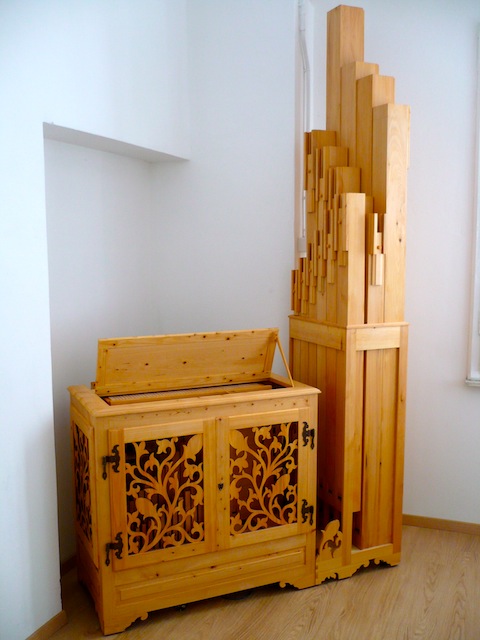
to David Rumsey’s mediæval page
Visitors to this web-site might like to know that Walter Chinaglia of Como (I) has designed and built a most interesting small organ. Based on historic models with Principals entirely of wood, it is a remarkably fine, flexible and useful instrument at a very reasonable cost. One was exhibited at the Rhede "gothic organ" conference in September 2012 (a report on that event is in preparation).
Chinaglia’s remarkable organo di legno brings to mind a passage in Benvenuto Cellini’s autobiography:
“My father began teaching me to play upon the flute and sing by note; but notwithstanding I was of that tender age when little children like to take pastime in whistles and such toys, I had an inexpressible dislike for it, and played and sang only to obey him. At this time my father fashioned wonderful organs with pipes made of wood, spinets the fairest and most excellent which could then be seen, viols and lutes and harps of the most beautiful and perfect construction.”
The entrancing Principals, made from a beautiful red-yellow cypress, which even contributes scent to the total experience, are available through the entire range of its keyboard at both 8' and 4' pitches (www.organa.it/page1/page14/page41/page41.html). An exquisite “little” Krummhorn-Regal (not heard on the web-site grabs) has a beautifully full and rich quality (which belies its pencil-thin resonators). This puts a strong and spicy finish to the tonal picture. Musical metaphors aside, the organ is practical: minimal in size for its resources, transportable by separating the lower octave or so of the Principal 8', which is in a block “outboard” so-to-speak, supplied by wind-conveyances. Both halves are then comfortably manageable by two people, the bass given a special set of wheels and the main section placed on a standard stage-trolley. Choosing the historically and musically optimum mean-tone tempering simply magnifies the beauty and concept of all these elements. However the flexibility of the pipe design and tuning arrangements allows a wide variety of temperings which can be quickly re- set, as required. Four basic pitches are available using a transposing keyboard (A1=390 - 415 - 440 - 465Hz). It all fits into a medium-sized van.
As a solo instrument it plays much of the keyboard repertoire of the “organo di legno” era brilliantly - there is a clarity in the bass never available from the metal Gedackts normally provided in such organs. As a general accompaniment instrument its qualities are very flexible for solo voices, choirs, instruments and all normal combinations of these. Even congregational accompaniment can be included here: the 8' gives a needed solid foundation, the 4' adds its special clarity for leading more substantial groups or ensembles, while the Krummhorn-Regal contributes the option of a kind of “reedy Plenum” which could easily control quite lusty assemblies of singers. A pedal board with pull-downs to the manual can also be provided on special order. Other options are also available.
As a continuo instrument it simply shines: the 8' has the pitch-definition and modesty in power to perfectly function in a basso-continuo rôle for solo arias or instrumental works, matching and supporting the sounds of Violones and Gambas, for example. The 4' can be used in its own right, or added when choirs or organo obligato solos are required. The Krummhorn-Regal will give all the contrast, power and richness desired for larger early-music ensembles, including brass instruments. From over 28 years of continuo experience in Sydney Town Hall and Sydney Opera House concerts, amongst many others, where the ubiquitous Gedackt 8’ + Flute 4' + Principal 2' + unspecific-but-even-more-squeaky 1' standard modern cabinet organ design proved itself inadequate, even annoying, on every occasion and at every level, Chinaglia’s organ would have been a dream.
Wood for continuo work is not just an Italian manifestation: Schnitger built them (wooden Principals), Bach recommended them (wooden Gedackts for continuo work at Mühlhausen in 1708). A recent reconstruction of a Schnitger variant is now used with great success by the German ensemble, chelycus.
